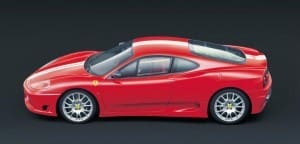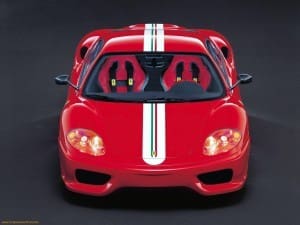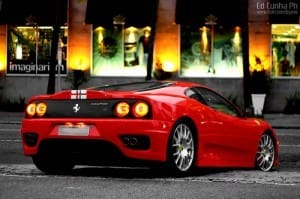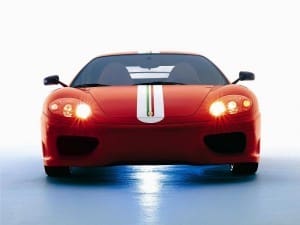The Ferrari 360 Challenge Stradale: a beautiful and epic car!
 The Challenge Stradale is a limited production more track day focused car than the 360 Modena, it was inspired by the challenge racing series and can be thought of as a Challenge car for the road. Ferrari engineers designed the car from the outset with 20% track day use in mind and 80% road use. With only a small 20 bhp (15 kW) improvement in engine power from the Modena, but with substantially improved power to weight ratio, the Challenge Stradale accelerates from 0 to 100 km/h (62 mph) in just 4.1 seconds.
The Challenge Stradale is a limited production more track day focused car than the 360 Modena, it was inspired by the challenge racing series and can be thought of as a Challenge car for the road. Ferrari engineers designed the car from the outset with 20% track day use in mind and 80% road use. With only a small 20 bhp (15 kW) improvement in engine power from the Modena, but with substantially improved power to weight ratio, the Challenge Stradale accelerates from 0 to 100 km/h (62 mph) in just 4.1 seconds.
In total, the CS is up to 110 kg (243 lb) lighter than the standard Modena if all the lightweight options are specified such as deleted radio, lexan side windows and fabric cloth (instead of the leather option). As much as 94 kilograms (207 lb) was taken off on the bodywork by stripping the interior carpets, lighter weight bumpers, carbon mirrors and the optional Modena carbon seats becoming standard. The engine and transmission weight was slimmed down 11 kg (24 lb) through the use of a smaller, lighter weight sports (yet still stainless steel) exhaust back box and valved exit pipes.
There are a lot of subtle (and some not so subtle) styling differences between the Challenge Stradale and the standard Modena.
These include:
Visual differences
- 19″ BBS Challenge Styled Alloys with Titanium wheel bolts
- Large Diameter Carbon Ceramic Brakes
- Carbon-fibre side mirrors
- Updated front and rear bumpers
- Pair of rear bumper diffusers
- Sharper side skirts
- Plexi-glass rear window
- Lower ride height on Titanium springs
- Lighter weight challenge grille (black metal mesh) made from Aluminium
- Challenge Stradale badging on rear grille
- Optional Tri-colour Racing Stripe
- Different exhaust tips to complement the lighter racing exhaust (the optional Modena racing exhaust became standard equipment on Challenge Stradale)
The car also had the optional carbon racing seats (available in 3 sizes, small, medium and large) which are noticeable from the outside to complement the interior detailing. These seats are a significant improvement in weight reduction over the standard seats.
Interior differences
- New instrument dials with a yellow rev counter and carbon fibre surround
- Carbon Fibre door panels
- Carbon Centre Console
- Fabric Dashboard with deleted stereo and glovebox
- New styled air ball vents (shared with 430)
- New Steering wheel with optional coloured racing ring
- Removal of carpets and lots of sound deading material (weight reduction)
- Rubber floor mats with optional fire extinguisher
Handling differences
- New stiffer rear anti-rollbar (hollow to make it lighter) and reduce body roll (same one fitted to 430 Scuderia)
- 360 Challenge cars uprated flanbloc’s replace all original rubber suspension bushes including anti-roll bar bushes (uprated) improving alignment on the move
- 20% stiffer uprated (progressively coiled) springs made from Titanium (lighter, lowering unsprung weight) and reducing pitch and roll
- Different suspension alignment and ride heights (rear higher than front to aid downforce)
- Titanium wheel bolts and carbon ceramic brakes (along with overall weight reduction) also contributing significantly to handling improvements (along with aero downforce improvements)
- Re-programmed electronic suspension control software with new ‘race’ mode (stiffer than Modena)
- Specially devised Pirelli Rosso Corsa (soft compound) track biased road tires (wider than Modena)
- Factory corner weighted suspension, additional care taken to corner weight each vehicle before it left the factory to match its exact weight with options fitted.
Dimensions
- Overall length: 4,477 mm (176.3 in)
- Overall width: 1,922 mm (75.7 in)
- Height: 1,199 mm (47.2 in)
- Wheelbase: 2,600 mm (102.4 in)
- Front track: 1,669 mm (65.7 in)
- Rear track: 1,617 mm (63.7 in)
- Dry weight: 1,180 kg (2,601 lb)
- Curb weight: 1,280 kg (2,822 lb)
- Fuel capacity: 95 L (25 US gal; 21 imp gal)
Performance
- 0–100 km/h (62 mph): 4.1 s
- Top speed: 300 km/h (190 mph)
- Downforce: about 270 kgf (2.6 kN) @ 300 km/h (without rear wing)
- Lift/drag: about -1.1:1
If you are still not convinced as to why this car deserves to be called epic, see the two video reviews I came across recently:
Review of the Ferrari 360 Challenge Stradale by Vicky Henderson-Butler of 5th Gear.
Review of the Ferrari 360 Challenge Stradale by Jeremy Clarkson of Top Gear.







